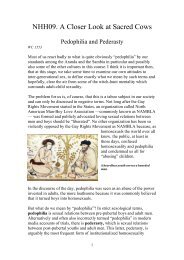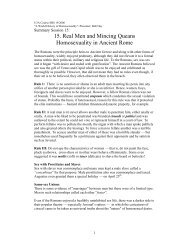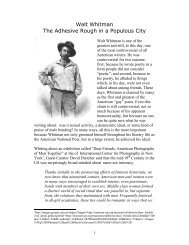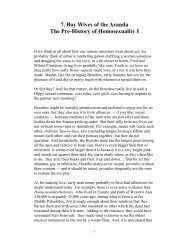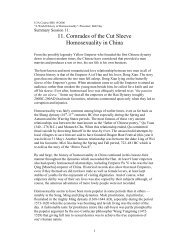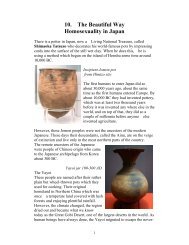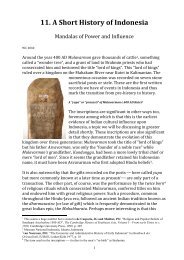NHH 10 The Beautiful Way - Homosexuality in Japan
NHH 10 The Beautiful Way - Homosexuality in Japan
NHH 10 The Beautiful Way - Homosexuality in Japan
Create successful ePaper yourself
Turn your PDF publications into a flip-book with our unique Google optimized e-Paper software.
It is commonly believed that it was Kukai himself who <strong>in</strong>troduced a form<br />
of homosexual activity which became <strong>in</strong>stitutionalised with<strong>in</strong> the Mt<br />
Koya monastery he founded on his return from Ch<strong>in</strong>a. This was called<br />
nanshoku which literally means “male colours” but is generally used to<br />
mean male-male love and specifically refers to the practice of monks<br />
form<strong>in</strong>g sexual alliances with their younger acolytes or chigo. 6 Whether<br />
it was true or not that Kukai himself was responsible is open to question,<br />
but the monastery at Mt Koya became a by-word for same-sex love, the<br />
monks rationalis<strong>in</strong>g their affairs with younger chigo on the grounds that<br />
the vow of chastity applied only to sex with women and not to sex with<br />
males because it was not procreative. A whole literature evolved of<br />
stories about love relations among monks and their young acolytes known<br />
as Chigo Monogatari. 7 Although these began <strong>in</strong> the N<strong>in</strong>th century, the<br />
practice of nanshoku persisted, becom<strong>in</strong>g more idealised as time went by.<br />
So, for example, when the first Portuguese traders made contact with<br />
<strong>Japan</strong> <strong>in</strong> the 15 th Century, the Jesuit priests who accompanied them<br />
reported home <strong>in</strong> horror that sodomy was plentiful <strong>in</strong> the Buddhist<br />
monasteries.<br />
<strong>The</strong> Love of Warriors — <strong>The</strong> <strong>Beautiful</strong> <strong>Way</strong><br />
In the early days of battles between uji or clans, the war chiefs led the<br />
men of the clan <strong>in</strong>to war, much as we might understand battles between<br />
the Scots clans. In the early “Classical” era, dur<strong>in</strong>g the Nara period (7<strong>10</strong>-<br />
794 AD), a system of local militias of mounted horsemen was<br />
established. Although orig<strong>in</strong>ally these men were the servants or samurai<br />
of the Emperor, gradually the militias evolved <strong>in</strong>to private armies ow<strong>in</strong>g<br />
loyalty to the great aristocratic families.<br />
<strong>The</strong>se early samurai were not the noble and cultured professional soldiers<br />
who followed the code later called bushido or “the way of the warrior”<br />
but men drawn from the lower classes who spent most of their time<br />
earn<strong>in</strong>g a liv<strong>in</strong>g as farmers and became soldiers only when their lords<br />
called upon them to fight oppos<strong>in</strong>g armies. <strong>The</strong> samuari who lived<br />
accord<strong>in</strong>g to the bushido did not emerge until the Tokugawa shogunate<br />
which began <strong>in</strong> the 17 th Century. By then the Samurai had become a class<br />
of highly tra<strong>in</strong>ed, discipl<strong>in</strong>ed professional soldiers who hired themselves<br />
out to clan chiefs and great houses dur<strong>in</strong>g the middle ages <strong>in</strong> <strong>Japan</strong>.<br />
6<br />
Gary Leupp: Male Colors: <strong>The</strong> Construction of <strong>Homosexuality</strong> <strong>in</strong> Tokugawa <strong>Japan</strong>, Berkeley:<br />
University of California Press, 1995.<br />
7 th<br />
<strong>The</strong>re were other references to homosexuality <strong>in</strong> other literature of the times: see, for example the 11<br />
century Genji Monogatari or <strong>The</strong> Tale of Genji.<br />
4



